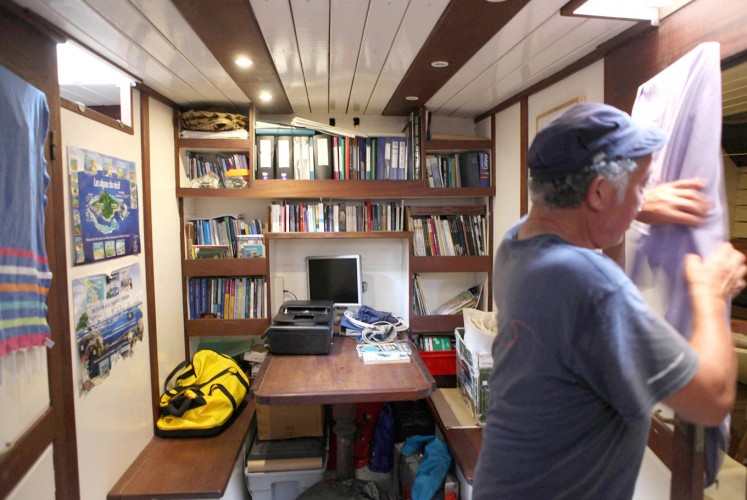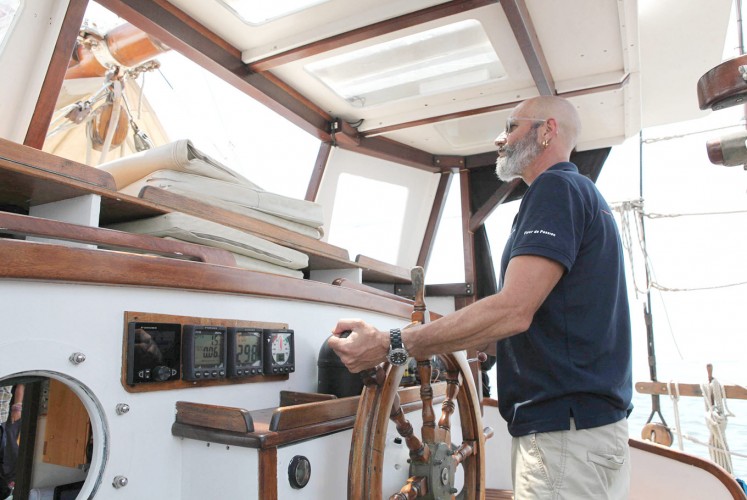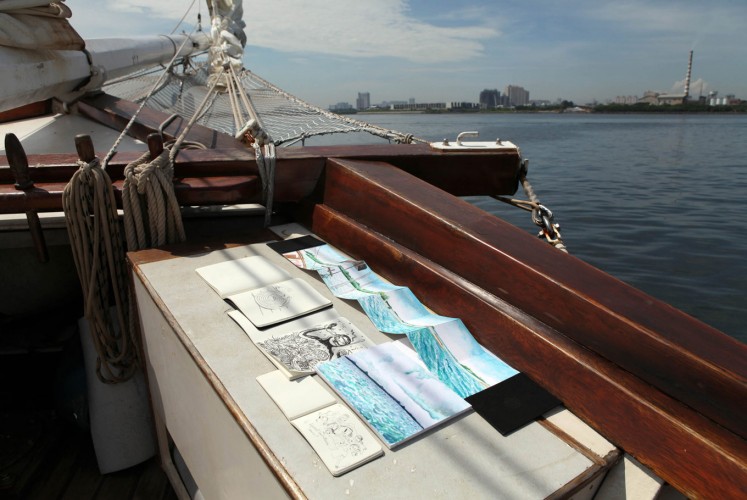Popular Reads
Top Results
Can't find what you're looking for?
View all search resultsPopular Reads
Top Results
Can't find what you're looking for?
View all search resultsSailing seas to save Mother Earth
The Fleur de Passion has gone through a fascinating evolution from a World War II German minesweeper into an expedition ship on a mission to mitigate climate change.
Change text size
Gift Premium Articles
to Anyone
T
he Fleur de Passion, a ship navigating the globe under the flag of landlocked Switzerland, used to sweep mines to save the Germans during World War II. After its transformation into a vessel with a scientific and educational mission in the 1970s, the ship now scans the ocean to save the planet from the worst ravages of climate change.
On a four-year journey that began in 2015 and will conclude in 2019, the Swiss expedition seeks to mark the 500th anniversary of Portuguese sailor Ferdinand Magellan’s worldwide cruise by tracking the impact of human activities on the oceans, particularly with regard to methane and carbon dioxide emissions produced by these activities.
According to Swiss Ambassador to Indonesia Yvonne Baumann, the expedition is possible thanks to the initiative of Geneva-based NGO Fondation Pacifique.
“The expedition also seeks to raise awareness about human impacts [with regard] to ocean pollution through a wide range of awareness activities,” Fondation Pacifique Vice President Samuel Gardaz said.
The ship’s ocean-mapping activities are conducted by a team of volunteers from Spain, France and other countries. They navigate the seas with the help of satellite mapping technology.
The ship embarked on its journey from Seville in Spain on April 13, 2015. The route was determined in honor of Magellan, who attempted to map the oceans of the Earth by traversing the same track.
While making their way on Magellan’s path, the crew took a sojourn in Jakarta from April 3 to 12, before heading for a six-week crossing of the Indian Ocean to Nosy Be in Madagascar.
Sanctuary: A ship volunteer tidies up its working room. (JP/Arief Suhardiman)According to Baumann, Swiss sailors and researchers have long been interested in Indonesia, making the sojourn in Jakarta a continuation of a long-held connection.
“Around the 17th century, the first Swiss merchants and researchers came to the archipelago, and they explored different islands,” Baumann asserted during her remarks aboard the Fleur de Passion at the port of Sunda Kelapa in North Jakarta.
She added that, back then, researchers discovered a number of interesting phenomenons in Indonesia, such as the volcanoes on Sumbawa Island in West Nusa Tenggara and the indigenous population that settled in Sulawesi.
This time around, the Fleur de Passion seeks to track climate change and environmental problems in the ocean, covering a number of elements: micro-plastic pollution, noise pollution, coral bleaching as well as greenhouse gas monitoring on the ocean surface.
Coral bleaching is caused by increasing water temperature, mainly due to pollution and overfishing.
The abovementioned research is conducted by Fondation Pacifique in collaborations with the University of Queensland, Australia, for coral bleaching, the Polytechnic University of Catalonia in Barcelona, Spain, for noise pollution and the University of Geneva for greenhouse gas monitoring.
University of Geneva Aquatic Physics Group Head Daniel McGinnis said climate change was one of the greatest challenges of our time, and understanding it was a major challenge for the scientific community.
“To effectively reverse the trend, scientists need to have a comprehensive and accurate view of the concentrations of greenhouse gases on the oceans’ surface and understand their role not only as reservoirs of such gases but also as emitters,” McGinnis explained.
Pere Valera Taltavull (JP/Arief Suhardiman)Noise pollution is another pressing environmental issue explored by the sailing scientists. According to Polytechnic University of Catalonia laboratory of bio-acoustic applications director Michel André, people might be oblivious to marine noise pollution, because it is invisible and inaudible, at least to human ears.
While the capacity of the human ear is too limited to discern noise pollution, its consequences for the ecosystem are devastating.
“Marine noise pollution is recognized today as one of the greatest disrupters of marine ecosystems that threaten the natural balance of the oceans […]. Noise pollution is, in fact, increasing with the development of industrial activities at sea and spreads at high speeds in all the corners of the planet,” André explained.
The ship is equipped with an ultraportable greenhouse gas analyzer with a sampling port positioned 16 meters above the water surface on the aft mast, which automatically logs methane and carbon dioxide readings every minute. To track how marine noise pollution has impacted the ecosystem, the ship utilizes devices that acoustically monitor the biodiversity of the ocean.
Recordings and water samples from the expedition are subsequently sent to the universities’ laboratories to be analyzed.
According to McGinnis, the researchers have so far revealed several emission hot spots, identifying areas that warrant further investigation due to high emissions.
“For example, methane was more than six times higher than background levels at Mactan, the Philippines, where the boat was anchored during a stopover there,” he explained.
As for micro-plastic pollution, the ship has collected 150 surface water samples from Seville to Singapore as of March 14. Currently, biologists from the Oceaneye organization are analyzing the samples. Their initial analysis reveals the presence of micro-plastic particles in various proportions polluting the ocean.
The expedition also provides a large database of coral bleaching across 77 countries for CoralWatch, an organization focusing on coral protection. The noise pollution research, meanwhile, has not only provided data on the problem itself but also tracked marine biodiversity through its acoustic device.
Gardaz said such programs afforded stakeholders an opportunity to access essential information at a very large geographical scale to complement that available by satellites and could address the lack of adequate scientific data that had so far frustrated scientists, considering the ominous nature of climate change.
“A pure civil society initiative, it illustrates once again the potential and interest of a sailing boat like the Fleur de Passion in terms of scientific research, in addition to more conventional oceanographic vessels,” Gardaz added.
Impressions on the sea: Sketches drawn by ship volunteers. (JP/Arief Suhardiman)The 33-meter long ship’s history is no less fascinating than the incredible service it is currently conducting for environmental studies.
Built in World War II, it was initially constructed as a motorboat that had a steel and wooden structure with no masts, which could be converted into a sailboat, according to Gardaz.
“In the mid-1970s, a French individual converted her into a sailing boat used for scientific and educational activities, but after a while, she had been put out of use,” he explained.
The ship’s next turn of fate occurred in the 1990s, when several adventurers from Geneva had discovered it in an extremely bad shape, almost a wreck, in Northern France, Gardaz said.
“They decided to revamp [the vessel]. The reconstruction actually took a long time, because they had to cut out some parts that were too rusty. They also had to build the ship’s deck and cabin areas as well as its roof anew, instead of renovating it, due to the extent of damage to those areas,” Gardaz explained.
After the renovation, the Swiss adventurers christened the ship Fleur de Passion, a name they had read in a novel.
The ship’s new name seems to invoke its crew’s passionate dedication to their environmental cause, despite the hardships of life at sea.
“Life on board is very different from life on land; we have to be very organized and considerate of other people, we can’t just use all the logistics as we wish, for example. The limited resources that we have to share while sailing, meanwhile, reminds us of the limited resources of the Earth, strengthening our commitment to taking care of it,” Fleur de Passion captain Pere Valera Taltavull said.














